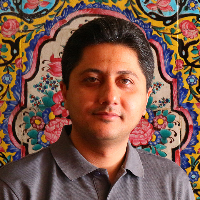Application of Social Perception Variables in Urban Rivers Regeneration (Case Study: Shiraz Khoshk River)
Author(s):
Article Type:
Research/Original Article (دارای رتبه معتبر)
Abstract:
Background And Objective
By definition, the urban landscape is a natural structure in an urban setting and research in social perception about studying the intangible norms that the landscape, as a medium, represented and transmitted throough the society. In this sense, in contrast to landscape restoration which has an ecological approach, social perception has fewer contributions to regeneration of urban streams. Shiraz Khoshk River is one of the natural and historical edges of city that has become a symbol of the city and one of its natural identities for lack of sufficient water, presence of physical interventions and valuable religious monuments in its path across the city. This paper aims to find out the social perceptions of Khoshk River in order to establish a practical framework for landscape regeneration of the urban streams. Hence, categorizing the citizens perceptions is inevitable and this could be defined as one of the research objectives.Method
This study relies on integrated strategies as a research method; we applied a complex description with a social survey within the case study using an exploratory content analysis approach. Besides, during assessing the social perception of residence, totally 32 person were chosen randomly through semi-structured interviews. Social perception variables obtained from literature review and categorized in two main groupes: landscape to society variables (six variables), and society to landscape variables (four variables). These variables were evaluated in a field survey (interviews and photography).Results
Results showed that the upper part of the river has higher potential for social perception than the middle and lower part. Furthermore, according to the survey, the social perception consists of some variables which could be categorized in three groups: natural environment variables, functional and activity variables and emotional variables appeared in the responses in priority order.Conclusion
In the social opinions, the noticeable elements of the river were in order of natural elements, arterial and manmade elements and at least functional-activity elements. It means that the relations between landscape and people are mostly a one-way direction than a two-way correlation. In another word, society to landscape variables is less considered than landscape to society variables. At the end, the principle of urban natural stream regeneration based on the case study and social perception of the landscape was modeled and proposed as cultural, symbolic and identical strategies, recreational strategies and social and legal sensitivity strategies.Keywords:
Language:
Persian
Published:
Journal of Environmental Sciences and Technology, Volume:18 Issue: 4, 2017
Pages:
395 to 417
magiran.com/p1787974
دانلود و مطالعه متن این مقاله با یکی از روشهای زیر امکان پذیر است:
اشتراک شخصی
با عضویت و پرداخت آنلاین حق اشتراک یکساله به مبلغ 1,390,000ريال میتوانید 70 عنوان مطلب دانلود کنید!
اشتراک سازمانی
به کتابخانه دانشگاه یا محل کار خود پیشنهاد کنید تا اشتراک سازمانی این پایگاه را برای دسترسی نامحدود همه کاربران به متن مطالب تهیه نمایند!
توجه!
- حق عضویت دریافتی صرف حمایت از نشریات عضو و نگهداری، تکمیل و توسعه مگیران میشود.
- پرداخت حق اشتراک و دانلود مقالات اجازه بازنشر آن در سایر رسانههای چاپی و دیجیتال را به کاربر نمیدهد.
In order to view content subscription is required
Personal subscription
Subscribe magiran.com for 70 € euros via PayPal and download 70 articles during a year.
Organization subscription
Please contact us to subscribe your university or library for unlimited access!


